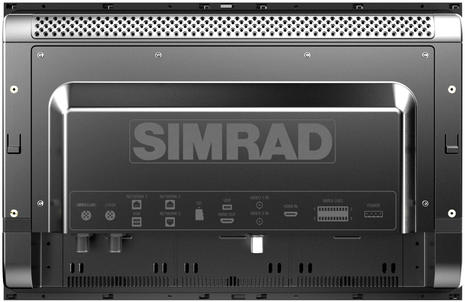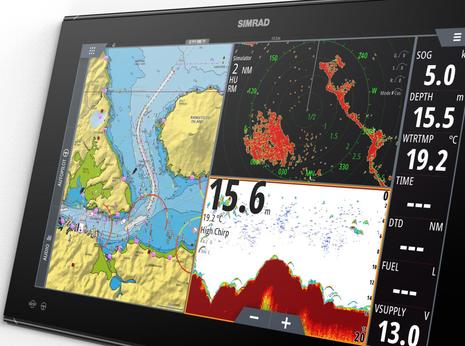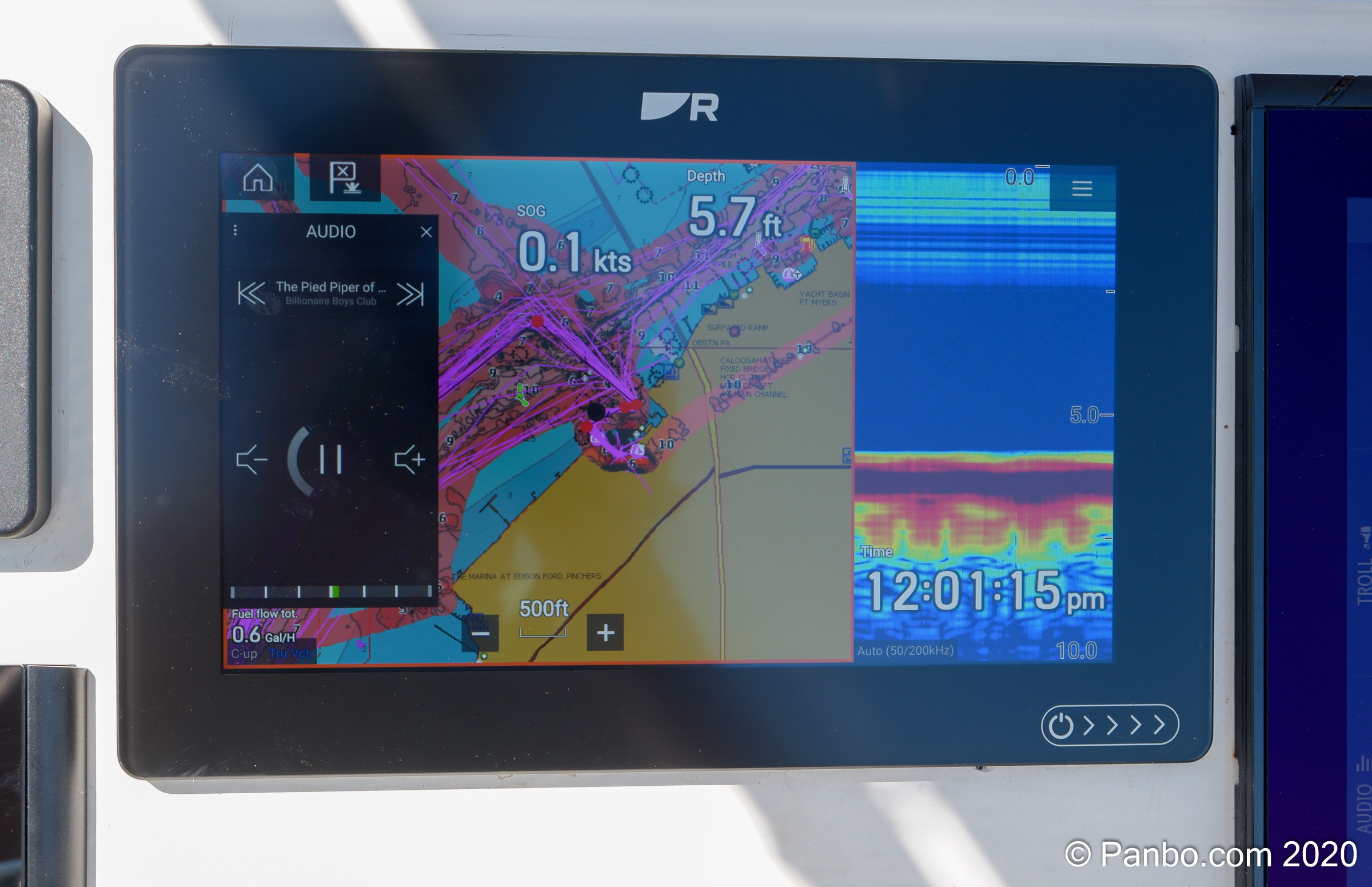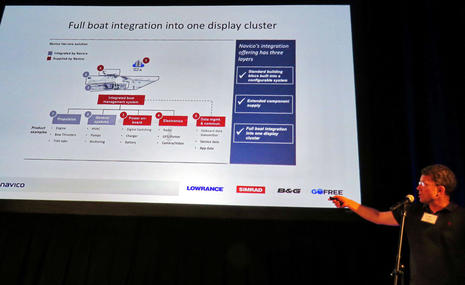Simrad NSO evo3 multifunction displays, and hints of Navico future
That new 24-inch Simrad NSO evo3 screen must look spectacular with its 1920 x 1080 pixel resolution, 1200 nits of brightness, and IPS-style wide viewing angles. And these big screens — there will be 16- and 19-inch models too — can purportedly be viewed with polarized sunglasses, thanks to the use of combined LCD and polarizer. The new NSO design is also packed with connectivity, including a Simrad-first J1939 engine input, and a black box processor is no longer needed. We’ve got details on the series, and then let’s ponder recent Navico acquisitions…
 Following the industry trend away from separate black box systems, Simrad has eliminated the NSO evo2 box and integrated all electronics into the displays. While possibly simplifying installation and minimizing space requirements, this change also means an upgrade or repair will require replacing the entire unit.
Following the industry trend away from separate black box systems, Simrad has eliminated the NSO evo2 box and integrated all electronics into the displays. While possibly simplifying installation and minimizing space requirements, this change also means an upgrade or repair will require replacing the entire unit.
Now as a high-end MFD, the NSO evo3 display is loaded with inputs and outputs. These include 3 ethernet ports, NMEA 2000, HDMI input, 2 composite video inputs, HDMI output, WiFi, and Bluetooth. Note, too, the 3 USB ports, which can currently be used for keyboard, mouse and mass-storage connections, according to Simrad, and obviously enable future features and functions. But the new NSOs are also the only high-end MFDS without the ability to support IP-cameras, though Simrad says that’s coming.
HDMI input means the NSO evo3s can display content from an entertainment system or PC, and Simrad says they are working on a way to send touch input from the NSO evo3 to a connected PC, possibly another use for those 3 USB ports. New with the evo3 generation of products is a J1939 input. Simrad joins Garmin’s 8400/8600 line in allowing engine data to be integrated for compatible J1939 engines without the need for a J1939 to NMEA 2000 gateway.
The new NSOs have the user configurable WheelKey first introduced on the NSS evo3. If there’s a Simrad autopilot connected to the system, this key will bring up its controls by default. Alternatively, the WheelKey can be set for two custom actions, one for a short press and another for long press (as shown above). Another interesting detail you can find in the NSO evo3 Operator Manual is the table above that shows all the keyboard shortcuts available when one is connected via USB. It’s easy to see the value of instantly being able to pull up a screen or type a waypoint name (if your helm can accomodate a full keyboard) and mouse clicking a route is another attractive possibility.
The NSO evo3 displays will run the same HEROiC OS seen on the NSS evo3, but with the added feature of six possible windows on a single screen (also now possible on Garmin 8400 and 8600 MFDs). With the overlap of 16″ units in both the NSS and NSO evo3 series, I asked Simrad about the difference between the two lines. The company explained that the NSO evo3 has higher spec processors and more I/O options. And this series is expected to be installed on larger boats with larger networks of related components like black box sonars, multiple radars, and so forth.
Simrad hopes to begin shipping the $6,999 NSO16 in late January or early February with the 19- and 24-inch models shipping in March. GPS receivers (and sonar processing) aren’t built into these MFDs, but optional kits include the GPS, a panel mount card reader, a NMEA 2000 starter kit, and an OP50 remote controller along with the MFD.
Incidentally, Simrad is more specific about the NSO evo3 processor — an iMX6 quad-core — than I’ve ever seen in marine electronics. Is this simply a response to Raymarine’s Axiom announcement in which much attention was given to its unnamed quad-core processors? Is it an industry trend that some consumers will appreciate?
Navico Future?
Navico recently acquired an interesting Swedish yacht systems integration company called Yacht Defined along with an interest in HOC Yachts, which is already using a strikingly modern looking navigation and control interface that earned Yacht Defined a Red Dot design award. And it’s not just the super-wide, 29-inch screen seen on the 33-foot HOC Explorer above (and below); the tablet and the wheel keypads seem to work seamlessly with the big screen to control just about everything. Glimpses of the system’s abilites can be seen in HOC videos like this and this (and here’s hoping that we can soon link to an impressive Yacht Defined demo video).
So while the underlying technologies are not clear — Android is hinted at, and some sort of digital switching is obvious — the small and young Yacht Defined team seem to have developed the sort of central boat hub that has long been dreamed of but rarely achieved. A year ago Panbo discussed Navico’s “Full boat integration in one display cluster” concept, and the HOC system seems quite close, except without Navico MFDs at its core.
So will NSS/NSO evo4 or 5 look like Yacht Defined. The problem is clear; anyone who owns more than a small boat — even a new and high quality one — likely knows the mishmash of screens and control panels that seem to cry out for more integration and simplification. A big challenge is getting control of all the possible systems, not just what goes into one small line of medium size powerboats. Only time will tell, but maybe Navico acquired a significant piece of the puzzle?
And one more thing. In September, Navico’s sister company C-Map acquired iSea, the Norwegian developer of the Embark “personal nautical map.” The iOS and Android app offers vector chart coverage of Europe, Australia, New Zealand and the USA. The free version is limited to online charts — “still pretty cool” says Ben Ellison, reporting below from New Bern, NC — while the paid version adds weather and AIS display to offline chart access.
But perhaps most interesting is Embark’s well-developed crowdsourced cruising guide feature, plus its ability to track and share your location with boating friends. Will good crowdsourced information capabilities make C-Map supported systems like Navico’s and Raymarine’s a viable competitor to Garmin’s ActiveCaptain? And if so, will different crowdsourcing from different brands mean we’re in for messy fragmentation in the whole concept?




















Ben, looks very cool and I just downloaded Embark which seems an excellent option for cruising boats… Official charts, paid by the month for a mere $2 or $3 per country? This is cruising boat heaven! No competitor offers this degree of flexibility, incredible for the traveling boat. Thanks for the tip.
Now, let’s talk about those Navico Simrad nice screenshots, using their latest software… I have the equivalent for Navico B&G. See all those newfangled menu software buttons on the upper corners and zoom buttons at the bottom? You can run the entire MFD with these buttons.
Oh, those are oh so perfect on an NSO screen or on a Vulcan, which have “NO” hardware buttons.
But what about us, who have an OP40 hardware controller, or simply an NSS/Zeus 2 with hardware buttons? Well, Navico did not use to have these software buttons, but they introduced them on the latest software updates, and cannot be disabled on hardware that does not need them.
Look, it’s great they are innovating, but really, if I wanted a Navico Vulcan interface I would have purchased a Vulcan w/o hardware buttons. I am sure others enjoy having the option of both sets of controls but I just think one should have the option of turning off the redundant screen clutter.
Cheers,
Xavier, NSS Evo2 has always had the Menu and Zoom soft buttons. Evo2 is lacking a hardware Menu button so it won’t work without the soft button. The software upgrade added the Pages button and changed the look of the other. I’m very happy they upgraded the Evo2 look to be the same as Evo3.
Ben, the processors used in NSS Evo2 have always been documented in the installation manual. The 7 and 9″ are using a single core i.MX6 while the two larger models are using a dual core from the same family. NSO Evo2 is using the quad core version, I don’t remember if it’s documented in the installation manual. There are now more effective Plus versions available of these processors, they were not available when the Evo2 models were designed. I don’t know if the plus versions are used in NSS and NSO Evo3 or not.
Looks as though the NSO Evo3 drew heavily on the Garmin 8600 series feature set with some further advancements. Now let’s see what Garmin comes up with. They should be not too far from an update on the 7600 series.
There will always be some strong inherent resistance to the idea of a single large screen replacing two smaller displays, especially if each has stand-alone processing capabilities. Not everyone has Gizmo’s multiple redundant displays!
Hello Abbor,
Here is a pic of a Zeus2 with software version 2. Clean screen, no ugly menu buttons in the corners cutting into the data display.
http://s329.photobucket.com/user/vww12/media/B_G_Zeus2_new_11-13-thumb-465xauto-8300.jpg.html
Here is a pic of a Zeus3 with software version 3. Redundant menu buttons in the top corners. Zeus2 updated to v3 look exactly the same. Redundant menu buttons cannot be disabled.
http://s329.photobucket.com/user/vww12/media/Zeus3_9.jpg.html
Cheers,
NSS Evo2 has always had menu and zoom buttons for charts and sonar.
This screen shot is from 2014
https://www.thehulltruth.com/attachment.php?attachmentid=927888&d=1504631729
I don’t find the Evo3 soft buttons which have migrated to Evo2 ugly, I think they are stylish and I find the addition of the Pages button handy.
A great feature of the evo3 WheelKey I meant to mention is that you can use it to switch between between windows on a split screen and then with long press make desired window full screen. That’s something I do fairly often on Garmin and Raymarine MFDs and I miss the ability on NSS evo2.
Ben,
I am curious how today’s agreement with Garmin will change Navico?
https://www.prnewswire.com/news-releases/navico-and-garmin-resolve-patent-disputes-300594527.html
B&G Zeus3 Glass Bridge MFDs are here:
https://www.bandg.com/bg/series/zeus-glass-helm-4d320410/
HenryD, I’m curious about the settlement terms — there was not a clear winner in my understanding — but I may never find out. In the meantime it sure sounds good that the patent fight is over and that they’ve even laid the basis for future cross licensing. Hopefully we won’t see products pulled off the market again, and also improved performance and features from both manufacturers. Like better down vision from Garmin and auto routing from Navico.
More boat integration: Garmin OneHelm announced today…
http://newsroom.garmin.com/press-release/featured-releases/garmin-launches-onehelm-integrated-solution-controlling-boat-systems
…and I’ll get a Miami demo tomorrow with Ben Stein.
Another great article and informative comments from your readers. Thanks.
I would like to highlight some concerns with the race to all touchscreen UIs as being the holy grail. Marketing loves it but R&D, support and the users don’t necessarily benefit. We’ve been here before in other industries. (1960s through the 2000s) The automotive, aerospace and naval experience of fully integrated systems without good tactile controls is well documented with two main issues.
Firstly moving platforms (those that experience acceleration and jerk motions) are not controllable with touch interfaces. Rotary controls and other tactile interfaces are key to maintaining control and situation awareness.
Secondly when we have fully integrated systems then continued utility when the system is degraded is less practical. Many of the interesting case studies in the military domain highlight the importance of being able to maintain situational awareness by referencing another independent system. Many lives have been lost due to crap UIs.
The technical comptetence and product quality from the marine vendors is also not great. I’ve experienced poor software quality issues when upgrading B&G Zeus2 systems, including UI bugs and bricking of AIS units. In 2017 this is not good enough. This makes me nervous in applying updates while cruising. Also digging under the hood of the Zeus2 and finding a many years out of date, niche Linux OS, just makes me shudder. The security and stability issues alone annoy me.
I look forward to the day when these vendors adopt the best practices of the technology industry and truly open source their non differentiating software and hardware.
“Simrad has eliminated the NSO evo2 box and integrated all electronics into the displays. While possibly simplifying installation and minimizing space requirements, this change also means an upgrade or repair will require replacing the entire unit.”
Which is why our boat is 90% through a navigation systems refit based on a ship’s computer using a stock gaming motherboard, stock screens, a suite of different navigation systems which I am going to experiment with (so far OpenCPN seems the best), iKommunicate gateway, etc. Every single component is open to every other, I can change anything I want without changing anything else, and if something breaks it’s not expensive to replace it. The boat will have a full glass bridge for the price of a single marine MFD. This approach is not for everyone and I’m not saying it’s the only or even the best way forward, but when I read that ‘ an upgrade or repair will require replacing the entire unit’ I think I made the right decision (for me). YMWV.
I’m immensely disappointed that the black box architecture has been dropped, but not surprised considering that there is more profit margin in selling multiple fully integrated displays compared to a single BB and a couple of dumb displays. The BB systems were problem not selling as much volume, so they cut it loose and will increase their total profits.
And no IP camera input? I was really feeling like a big fan of Simrad until I read the specs on the evo 3. This just feels like a massive downgrade.
Simrad announces Information Display:
https://www.simrad-yachting.com/information-display/
Is this maybe the first public fruit of their acquisition of Yacht Defined?
Thanks, Kim! I totally agree and said so after we published the press release yesterday:
https://panbo.com/navico-shifts-electronics-paradigm-with-introduction-of-new-display-category/
Oh, I missed that one, thanks Ben!